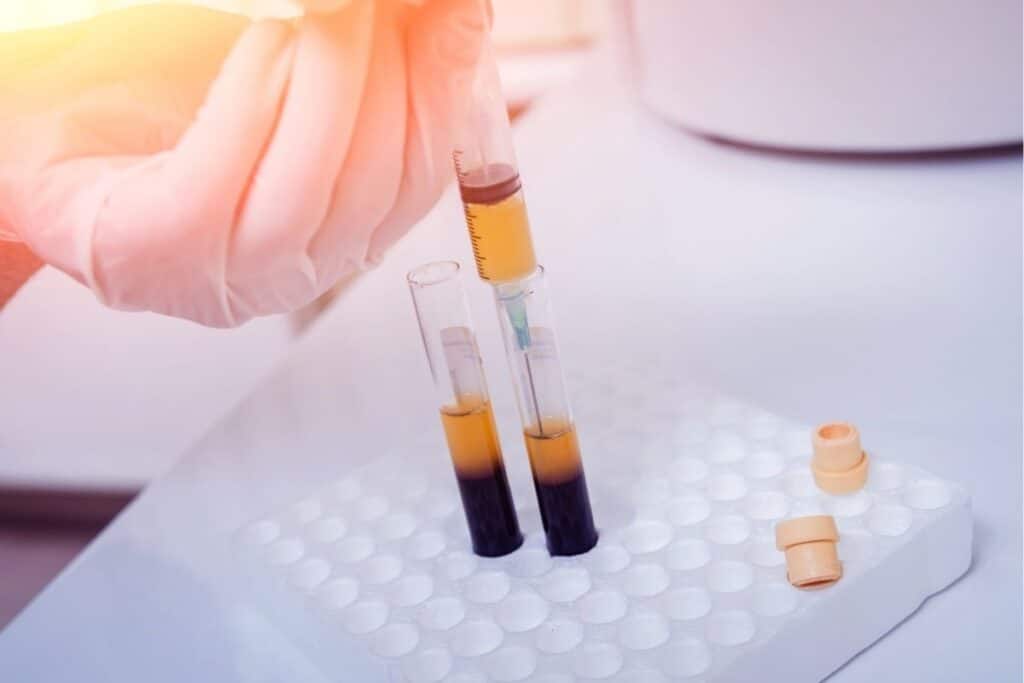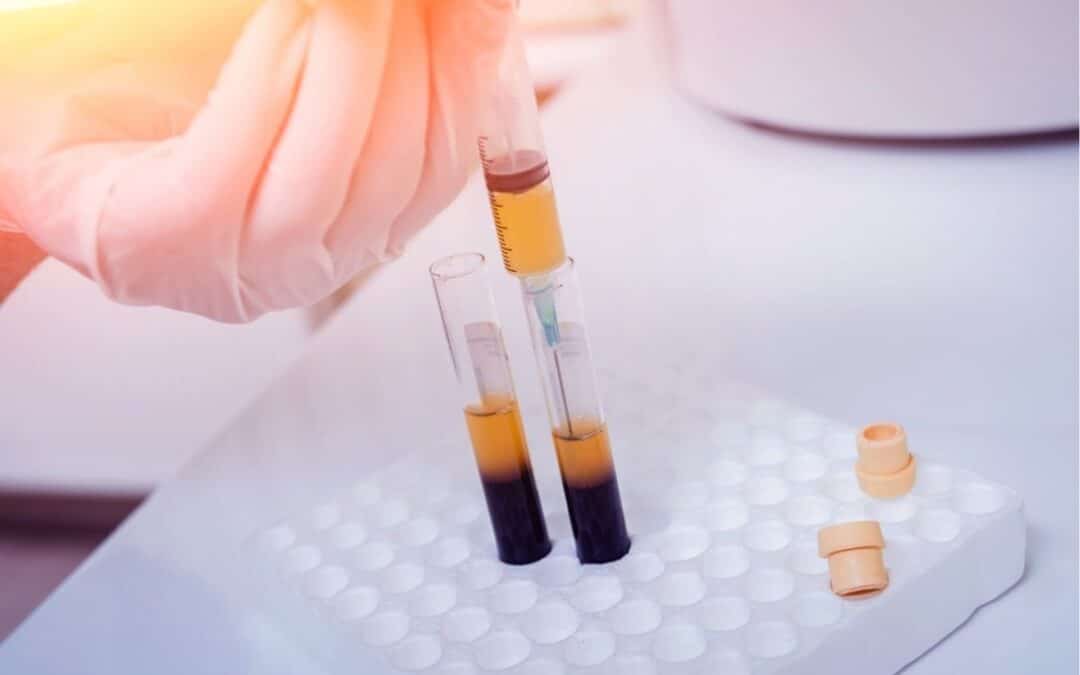Therapy treatments involving platelet rich plasma (PRP) injections have been gaining in popularity for a whole host of conditions, including everything from hair loss to sports injuries.

The therapy involves injecting the patient’s own blood cells back into an area that requires specific healing or increased blood flow. The treatment can then support and speed up healing.
PRP Therapy As A Treatment
Platelet rich plasma has two main components (both of which are taken from the patient’s own blood): plasma and platelets.
Plasma is the liquid portion of the blood that you may have already seen – it is straw colored, and can leak from cracked scabs or zits that you have squeezed.
Platelets are a kind of blood cell which play a really integral role in healing all across the body, though they are most well known as the compound in your blood that helps it to clot and form scabs.
Clotting blood isn’t their only role though. They also contain growth factors and can trigger cell reproduction, or stimulate an increase in tissue regeneration.
When creating PRP, the clinician will take a blood sample from the patient and then put it in a device called a centrifuge, which rapidly spins the blood, to separate out all of the components by density.
The platelets are concentrated in the plasma liquid, and other cells present in the blood are disposed of.
The platelet rich plasma solution is then injected into a target area, like an injured tendon.
In theory, this injection will increase the concentration of beneficial bioprotiens or hormones (which are also called growth factors) in the area, which will then speed up the healing process.
However, the mechanism by which PRP therapy actually works is still quite unknown, but the benefits are clear. Studies have found that the healing process is sped up, shortening the healing time for injuries, and even decreasing pain.
Platelet Rich Plasma Therapy For Arthritis
PRP therapy takes advantage of the blood’s natural healing ability, using it to stimulate and speed up the healing of injuries that have damaged cartilage, tendons, ligaments, muscles and even bone.
Arthritis, a degenerative disease, affects the cartilage lining of a joint, meaning that is starts to disintegrate, and lose its smooth surface, or can be caused by an immune response.
In any case, arthritis is associated with pain, swelling, and stiffness, which impacts the patient’s comfort and mobility in day to day life.
When treating osteoarthritis with PRP, your doctor will inject your own platelet rich plasma into the affected joint(s), which can reduce pain and swelling, improve the joint’s functioning and mobility, and possibly slow, halt, or in some cases, even repair damage to the cartilage.
Though medical professionals aren’t totally sure how PRP injections alleviate the symptoms of orthopedic conditions, theories about how it helps osteoarthritis include:
- Inhibiting any inflammation, which in turn slows down the progression of osteoarthritis.
- Stimulating the formation of new cartilage because of growth factors in the platelet rich plasma.
- Proteins in PRP can also alter a person’s pain receptors, which then reduces their sensations of pain.
However, before jumping in to PRP therapy head first, it is important to know that none of these effects have been proven by large scale studies, only early trial.
It could be that PRP does all of these things, or that it does none of them. Always do your own research and talk to your healthcare professional about all of your options.
Platelet Rich Plasma Injections For Knee Pain
The knee is a tricky joint, and there are a multitude of things that can go wrong with it.
Thankfully, there is promising evidence that PRP injections may be able to help with knee pain – especially when it comes to osteoarthritis.

PRP injections may be able to lessen the pain, inflammation, and swelling in the knee by reversing already existing damage that has occurred to the tissue.
When compared with placebo injections, PRP injections significantly reduced the scores that patients gave to their pain at a follow-up appointment (i.e., they experienced lower levels of pain, or even no pain at all).
Furthermore, when compared with control participants, those who received PRP injections said that the physical function of the joint had massively improved.
PRP Treatment For Hair
Platelet rich plasma injections can be effective when used to treat male pattern baldness – both in promoting new hair growth when a patient has already balded, and preventing hair fall in the first place.
Most of the research that has been done into PRP therapy and hair loss has been into the condition, androgenic alopecia (also known as AGA, or hormone related baldness), which can affect both men and women.
PRP treatment has been successful for the prevention of hair loss, and the regrowth of lost hair caused by an excess of the androgen (testosterone) hormone.
Particularly, it has been shown to be effective when used in conjunction with other treatments for AGA, like the topical chemical minoxidil, or the oral supplement finasteride, which is an anti-androgenic drug.
PRP injections can also be beneficial when it comes to getting hair transplants to ‘take’, and encouraging the hair to grow healthily.
However, there is not enough evidence for us to conclude that PRP is effective against other kinds of hair loss, such as telogen effluvium (stress related), androgen areata (autoimmune related non-scarring hair loss), or forms of scarring hair loss.
Platelet Rich Plasma Injections For Shoulder Pain
The shoulder is another difficulty joint that is often subject to sports, or every day life injuries.
Specifically, issues with the intricate networks of tendons and ligaments can really wreak havoc, and those who suffer tendon problems in the shoulder and rotator cuff are frequently subject to repeated injury.
Typically, these injuries can be chronic, or take a really long time to heal.
Adding PRP therapy to a treatment regimen (among side other treatments, like physical therapy, pain management, and rehabilitation) can help to stimulate the healing process through the addition of a concentrated form of platelets.
Studies have found that PRP shots to the shoulder after injury can decrease pain, and speed up healing, so that you are able to return to activities sooner.
Final Thoughts
Platelet rich plasma therapy can be a great option if you are suffering from tendon, ligament or joint pain, or you have experiences hair loss. This might be because the PRP is rich in platelets, the healing cell.
In fact, PRP has about five times the concentration of platelets than normal blood.
However, much of the medical research into PRP therapy is still in its early stages, and often treatments like this can be highly subjective, based on you and your injury.
Always do extensive research and speak to a medical professional before you embark on any course of treatment.

